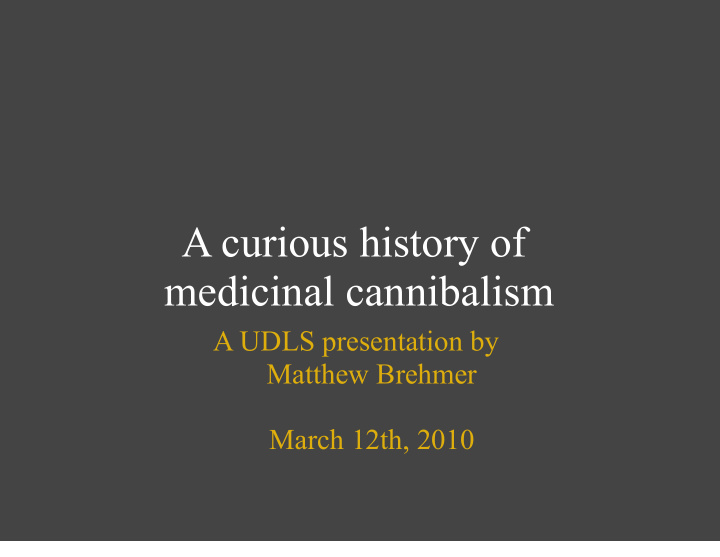



A curious history of medicinal cannibalism A UDLS presentation by Matthew Brehmer March 12th, 2010
Disclaimer The aim of this presentation is to describe strange and fascinating accounts of unorthodox medicinal treatments. It is not my intent to disgust you. Nevertheless, please be aware that some of the following material may be unsettling.
What I will not be discussing... Cannibalism relating to... • Ritual customs / sacrifices • Taste / mental illness • Desperation • War / intimidation
What? (Mostly historical) accounts of medicinal treatments involving the use of human tissues and fluids ! ! discussion of the use of human waste and abortus will be minimal
Where & when? Medieval & Renaissance Europe
Where & when? Sung (960-1126) - Ming (early 1900s) China
Where & when? Ancient to early 1900s Middle East
Why? • The ancient universal belief of the predetermined lifespan; should it be interrupted before its due time... • Folk wisdom, hearsay, lack of a scientific method • Simple association o Rheumatism? Use marrow, distilled bone oil! o Hair loss? Use distilled hair elixir! o Jaundice? Use urine! o Going nuts? Use spirit of skull!
Europe • Nicolas Lémery (1645 - 1715), French chemist: o "recommended woman's milk for inflamed eyes, feces were applied to sores, and the human skull, brain, blood, nails and "all the parts of man", were used in sixteenth century Europe" • The 17th Century Cordic Dispensatory o Fancy product names, with added herbs: o Woman Butter, Poor Sinner's Fat, Maid's Zenith, Spirit of the Brain of Man (brain with peony, black cherries, lavender, lily)
Europe: They're making a killing! • Blood and fat of executed criminals o blood: epilepsy, gout, dropsy (edema) o fat: rheumatism, joint pain, "falling-away limbs" • Warm gladiator blood (epilepsy) • Dutch surgeons on the battlefield
Aside: on epilepsy Historically, it was best to avoid being epileptic Among the treatments: • distilled human skull • dried human heart • warm gladiator blood • bolus of human mummy • arsenic, cod liver oil, borax • various animal excrements • etc...
Aside: on blood • Epilepsy, gout, dropsy (edema), eczema • Blood baths for Leprosy • Blood for beauty / youthful appearance o Elizabeth Báthory - the "Blood Countess" (1560 - 1614)
Chinese Medicinal Cannibalism • Chinese Materia Medica , a 1597 compendium of medicinal plants / animals compiled by great naturalist Li Shih-Chen o human dandruff (from fat man), knee dirt, ear wax, perspiration o "old liquified placenta to quieten a patient whose hair stands up on end" • Chinese scholar Key Ray Chong: o "filial duty to ailing parents" • Bizarre murders to restore youth / vitality
Mummy elixir • Found in chemistry books in 16-18th century Europe (Nicolas Le Fevre - A Compleat Body of Chymistry ) • Kept stocked by Pierre Pomet - private druggist to Louis XIV (1737's Compleat History • palsy of Druggs) • vertigo • 1929's Mystery and Art of the • treatment of contusions Apothecary by C.J.S. • preventing coagulation of Thomson: mummy could still blood (bruises) • flatulence be found in near east bazaars • catching fish
Mellified man • Dead human remains steeped in honey • Documented by Li Shih-Chen in the Chinese Materia Medica • Honey is antiseptic, antibacterial, preserving agent • applied topically to wounded or broken limbs • small amounts ingested orally • *May have been a myth*
A note on spittle... • Popular among Ancient Romans, Jews, and Chinese • Refrain from using your own! • Ancient pharmacological texts called for woman spittle, newborn man-child spittle, Imperial spittle • Cure for ophthalmia • Remedy for nightmares
Modern medicine & chymistry explains • bile for deafness (earwax buildup) • human toenail or excrement as an emetic • saliva as a natural antibiotic • placebo response • tinctures were mostly opiates and alcohol anyway... o King Charles Drops - from Charles II's private laboratory in Whitehall: o sprit of skull + opium + wine
The modern era • 1977 Great Dictionary of Chinese Pharmacology: "human fingers, toes, nails, dried urine, faeces, breast milk strongly recommended to cure certain diseases" • Bernard E. Read, editor, 1976 Chinese Materia Medica : "today people are feverishly examining every type of animal tissue for active principles, hormones, vitamins, and specific remedies for disease, and discovery of adrenaline, insulin, theelin, monotoxin, and others, compels an open mind that one may reach beyond the unaesthetic setting of the subject to things worth while"
The modern era - blood transfusions • Soviet Russia's use of cadaver blood in blood transfusions: Sklifosovsky Institute in Moscow o cadavers belonged to the state anyway o 28 years of transfused cadaver blood - 25 tonnes - meeting 70% of clinics' needs • Only one doctor (Jack Kevorkian) successfully replicated this in North America
The modern era - placenta • Treatment for post-partum depression • Also used historically for treatment of delirium, weakness, loss of willpower, pinkeye • Advocated by several popular pregnancy web sites Virtual Birth Centre's o recipes for lasagne, pizza, etc. Placenta cocktail: • 8oz V8 • TV Dinners cooking show on • 2 ice cubes British Channel 4: • 1/2 cup carrot o garlic-fried placenta • 1/4 cup raw placenta • puree for 10s
Further Reading • Roach, M. (2003). STIFF: The Curious Lives of Human Cadavers . Norton, New York. p. 221-247. • Wikipedia: o Cannibalism o Chinese Cannibalism o Chinese Materia Medica o Mellified Man • All images Creative Commons / Wikimedia Commons
Recommend
More recommend